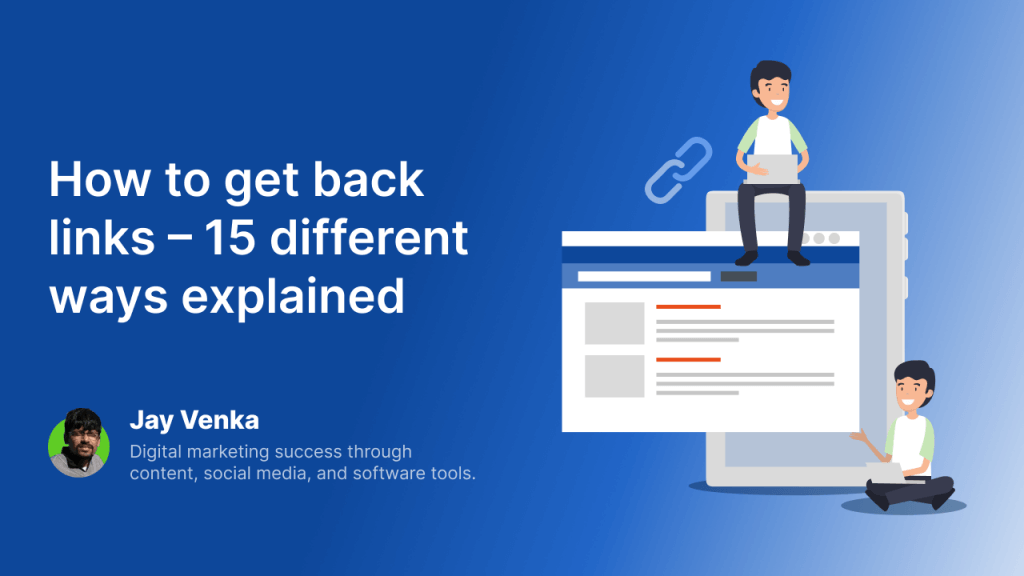
A detailed guide on 15 different ways to get backlinks for your website, blog or articles.
Table of content:
-
Resource pages
-
Using infographics
-
Guest blogging
-
Link building using broken links finder
-
Press releases
-
Commenting on relevant blogs
-
Testimonials
-
Tools and Utilities:
-
Quizzes and Giveaways:
-
Creative ways to build backlinks
-
Backlinks via Ebooks
-
Long form blog posts and research content:
-
Buying related websites:
-
Ecommerce sites:
-
Free blogs
1. Resource pages

Resource pages are great backlink winners. Resource pages usually have a collection of all resources and links to them in one single page that can be navigated and printed. Resource pages will offer more of a macro view of the topic.
Check our Free resource page generator tool
Here are some examples of resource pages:
-
A list of the best SEO tools for small businesses
-
A guide to starting a blog
-
A list of the top 100 websites in the world
-
A resource page for digital marketing teachers
Resource pages can be a great way to provide value to your audience and improve your website’s SEO. Here are some tips for creating a resource page:
-
Choose a topic that is relevant to your audience.
-
Do your research and find the best resources for your topic.
-
Organize your resources in a way that is easy to navigate.
-
Use keywords throughout your resource page to help people find it when they are searching for information.
-
Promote your resource page on social media and other online platforms.
2. Using infographics
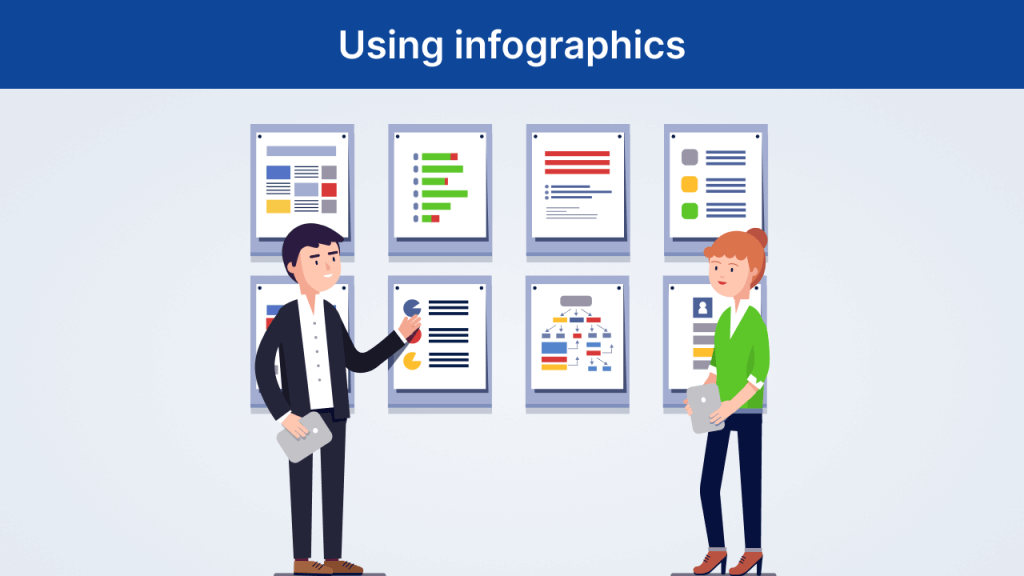
Here are some tips for designing infographics:
-
Start with a clear goal. What do you want your infographic to achieve? Do you want to educate your audience, persuade them to take action, or simply entertain them? Once you know your goal, you can start to gather the information you need. Then, design your infographic accordingly.
-
Choose the right data. Not all data is created equal. When choosing data for your infographic, make sure it is relevant, accurate, and interesting. You should also consider the format of your infographic. For example, if you are creating a timeline infographic, you will need to choose data that is chronological.
-
Use visuals to tell your story. Infographics are all about visuals. Use images, charts, and graphs to help tell your story and make your data more engaging. Be sure to use visuals that are clear, concise, and easy to understand.
-
Keep it simple. Infographics should be easy to read and understand. Avoid using too much text or too many visuals. Stick to a simple design that will make your data easy to digest.
3. Guest blogging

Here are some tips on how to seek opportunity for guest blogging:
-
Identify relevant blogs. The first step is to identify blogs that are relevant to your niche or industry. You can do this by using Google search, social media, or industry directories. Some of the tools below can help to find relevant blogs in your niche
Google search: using popular keywords in your niche and collecting the top ranking blogs
Use tools like Technorati and Alltop to find popular and relevant blogs related to your niche.
-
Find blogs that accept guest posts. Once you’ve identified a few relevant blogs, you need to find out if they accept guest posts. You can usually find this information on the blog’s website or in the blog’s author guidelines.
-
Pitch your ideas. Once you’ve found a few blogs that accept guest posts, you need to pitch your ideas. Your pitch should include a brief overview of your idea, as well as a link to your website or blog.
-
Follow up. After you’ve pitched your ideas, be sure to follow up with the blog owner. This will show that you’re interested in the opportunity and that you’re serious about guest blogging.
-
Be selective. Don’t pitch your ideas to any blog that will accept them. Be selective and only pitch your ideas to blogs that are relevant to your niche and that have a good reputation.
-
Be patient. It may take some time to get accepted as a guest blogger. Don’t get discouraged if you don’t get accepted right away. If you keep pitching your ideas, you’ll find blogs that are interested in what you have to say.
-
Be persistent. If you’re interested in guest blogging for a particular blog, don’t give up after one pitch. Keep pitching your ideas until you get accepted.
4. Link building using broken links finder
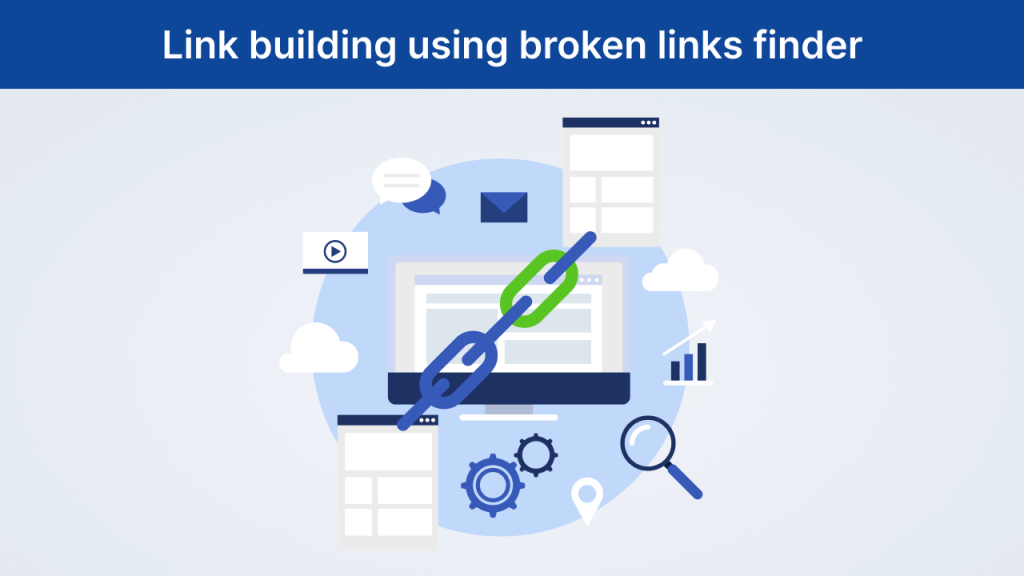
-
Use a broken link checker tool.
There are many free and paid broken link checker tools available online. These tools will scan your website for broken links and generate a report that you can review. Some popular broken link checker tools include:
-
Google Search Console
-
Screaming Frog SEO Spider
-
Ahrefs Broken Link Checker
-
Link Detox section in SEMrush
-
Manually check for broken links.
If you don’t want to use a broken link checker tool, you can manually check your website for broken links. To do this, follow these steps:
-
Open your website in a web browser.
-
Click on each link on your website.
-
If a link doesn’t work, it will either return a 404 error or it will take you to a page that doesn’t exist.
-
Once you’ve found all the broken links on your website, you can fix them by updating the links or by removing them altogether.
-
Use Google Analytics.
You can also use Google Analytics to find broken links on your website. To do this, follow these steps:
-
Go to your Google Analytics account.
-
Click on the “Behavior” tab.
-
Click on the “Site Content” report.
-
Click on the “All Pages” link.
-
In the “Status Code” column, look for pages that have a status code of 404.
-
These pages have broken links.
Once you’ve found all the broken links on your website, you can fix them by updating the links or by removing them altogether.
-
Use a WordPress plugin.
There are many WordPress plugins that can help you find broken links on your website. Some popular WordPress broken link checker plugins include:
-
Broken Link Checker
-
Broken Link Status
-
Check My Links
-
Redirection
These plugins will scan your website for broken links and generate a report that you can review.
-
Use a sitemap.
If you have a sitemap, you can use it to find broken links on your website. A sitemap is a file that tells search engines about the pages on your website. It can also be used to find broken links.
To use a sitemap to find broken links, follow these steps:
-
Go to your website’s root directory.
-
Open the sitemap file.
-
Look for any pages that have a status code of 404.
-
These pages have broken links.
Once you’ve found all the broken links on your website, you can fix them by updating the links or by removing them altogether.
By following these steps, you can find and fix broken links on your website. Broken links can negatively impact your website’s SEO and user experience, so it’s important to fix them as soon as possible.
5. Press releases

Here are some tips on how to write a trendy press release:
-
Start with a strong headline. Your headline is the first thing that journalists and bloggers will see, so it’s important to make it strong and attention-grabbing. Use keywords that are relevant to your industry and that will help people find your press release.
-
Keep it short and to the point. Journalists and news site admins are busy people, so they don’t have time to read long press releases. Get to the point quickly and clearly.
-
Proofread carefully. Typos and grammatical errors will make your press release look unprofessional. Before you hit send, be sure to proofread your press release carefully.
-
Press releases are usually text-based news. They do not have much scope for visuals. If there are visuals, be sure to include proper branding elements, such as the company logo or product branding images.
6. Commenting on relevant blogs

Here are some tips on how to search for blogs to comment on:
-
Use Google search operators to find relevant blogs in your niche that allow comments. For example, you can use the following query: NICHE + “Leave a reply”Spy on your competitors and see where they are leaving comments. You can use tools like Ahrefs or Moz to find their backlink profile and identify the blogs they are commenting on12.
-
Use Google Alerts to get notified of new blog posts in your niche that you can comment on.
-
Subscribe to blogs from your niche that you like and follow their updates.You can use a feed subscription service to read your favorite blogs and comment on them too
-
Use Google search. You can use Google search to find blogs that are relevant to your niche or industry. To do this, simply type in a keyword or phrase that is related to your topic. For example, if you are interested in blogging about marketing, you could type in “marketing blog” or “best marketing blogs.”
-
Social media. You can also use social media to find blogs. Many blogs have active social media accounts, where they share their latest posts and interact with their readers. To find blogs on social media, simply search for keywords or phrases that are related to your topic. For example, if you are interested in blogging about fashion, you could search for “fashion blog” or “fashionista.”
-
Industry directories. There are many industry directories that list blogs in a particular niche or industry. These directories can be a great way to find blogs that you may not have otherwise found. Some popular industry directories include:
-
Google search
-
Technorati
-
WordPress.com blogger search
-
Blogger.com blogger search
-
-
Word of mouth. Ask your friends, family, and colleagues if they know of any relevant blogs. They may be able to point you in the direction of blogs that you would not have otherwise found.
Once you have found a few relevant blogs, you need to evaluate them to see if they are a good fit for you. Consider the following factors when evaluating a blog:
-
Relevance. Is the blog relevant to your niche or industry?
-
Quality. Is the blog well-written and informative?
-
Audience. Is the blog’s audience a good fit for your target audience?
-
Traffic. How much traffic does the blog get?
-
Engagement. How engaged is the blog’s audience?
By evaluating these factors, you can find blogs that are a good fit for you and your goals.
Here are some more tips for searching for blogs to comment on:
-
Look for blogs that are active and engaging. You want to comment on blogs that are active and have a large audience. This will help you get your comments seen by more people.
-
Look for blogs that are relevant to your niche or industry. This will help you ensure that your comments are relevant and that you are adding value to the conversation.
-
Be genuine and helpful in your comments. People can spot a fake from a mile away, so be sure to be genuine and helpful in your comments. This will help you build relationships with other bloggers and establish yourself as an expert in your field.
-
Be patient. It takes time to build a following and establish yourself as a valuable commenter. Don’t get discouraged if you don’t see results immediately. Just keep commenting on blogs that you enjoy and that you think you can add value to.
7. Testimonials
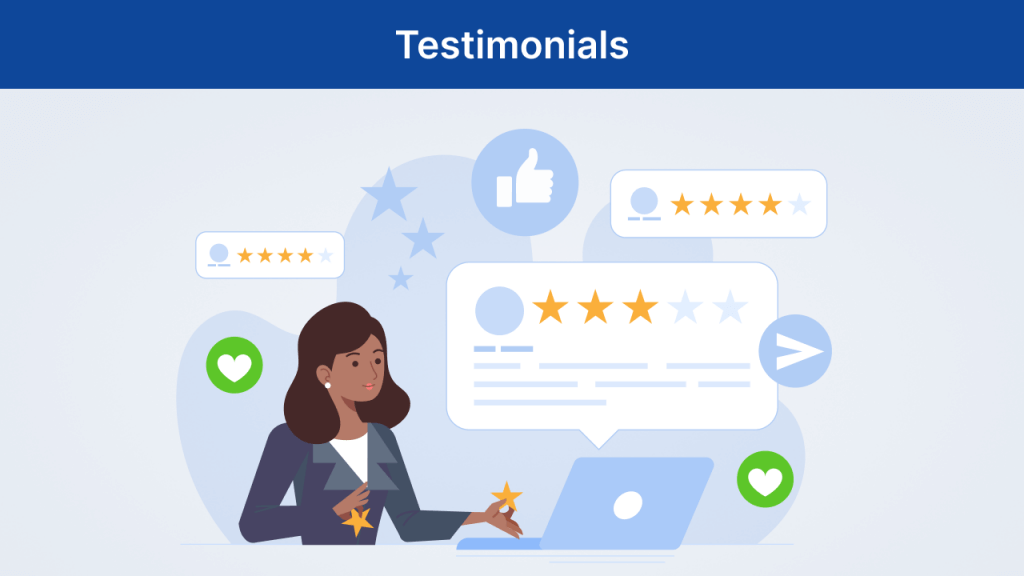
Testimonial link building is a great way to build backlinks to your website. It’s a win-win situation for everyone involved. You get a backlink, and the company gets a positive testimonial.
Here are some tips on how to build backlinks using testimonials:
-
Find relevant companies. Start by finding companies that are relevant to your niche. You can do this by searching for keywords related to your business. Or, look for companies that have featured testimonials on their website.
-
Reach out to the companies. Once you’ve found a few companies, reach out to them and ask if they would be interested in featuring a testimonial from you on their website. Be sure to include your website address in your email so that they can link back to you.
-
Write a great testimonial. When you write your testimonial, be sure to be specific and positive. Mention the company’s name, the product or service you used, and why you were happy with it.
-
Follow up. After you’ve submitted your testimonial, be sure to follow up with the company to make sure they received it. You can also ask them if they have any questions or if there’s anything else you can do to help.
8. Tools and Utilities

Hosting custom tools and utilities in your domain is a great way to attract users. They not only seek information but also put it to use. These tools hosted in your domain are great for backlinking.
Examples: In weight loss niche – BMI calculator, steps calculator, calorie counter
In finance niche: rate calculators, interest calculators
Apart from hosted tools you can also have downloadable tools, templates, spreadsheets in your site and it can gain backlinks.
9. Quizzes and Giveaways

Quizzes are fun. People like to share the quiz and the results in social media and brag about the same. The quiz pages are great for gaining backlinks apart from all other benefits they have like generating traffic, generating leads, brand exposure etc
Giveaways are time sensitive events which have leaderboards, rewards or prize attached to it. Great way to generate visibility and build backlinks
10. Creative ways to build backlinks
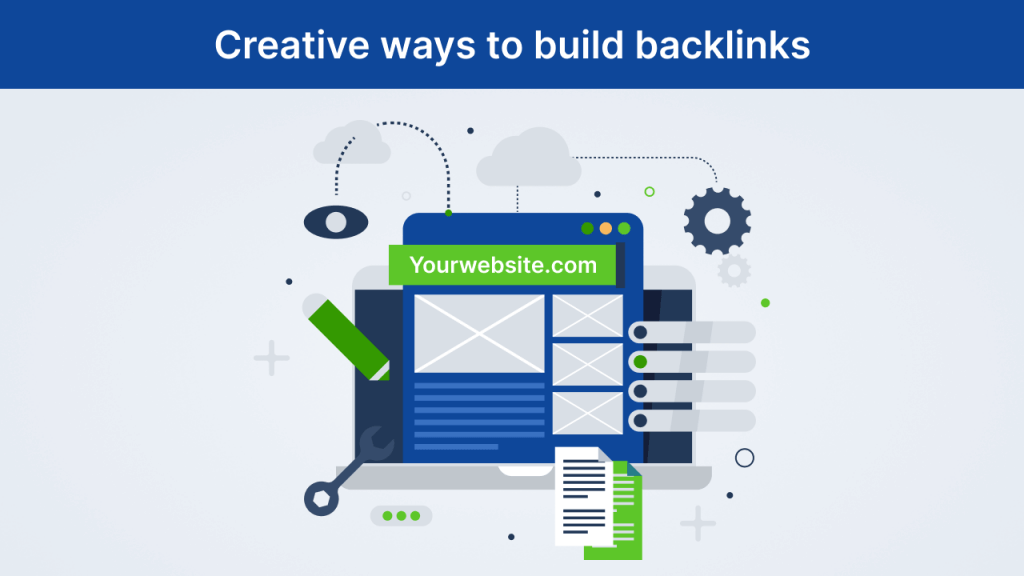
-
Attend industry events: Attending industry events is a great way to meet other professionals in your industry and build relationships. When you meet other professionals, be sure to give them your business card and ask them to link to your website from theirs.
-
Use creative ways you can promote your website via offline methods like business cards, T-shirts and other memorables like coffee mugs. GEtting the word out to the real world with your website name as your brand is another cool way to get some reference
11. Backlinks via Ebooks
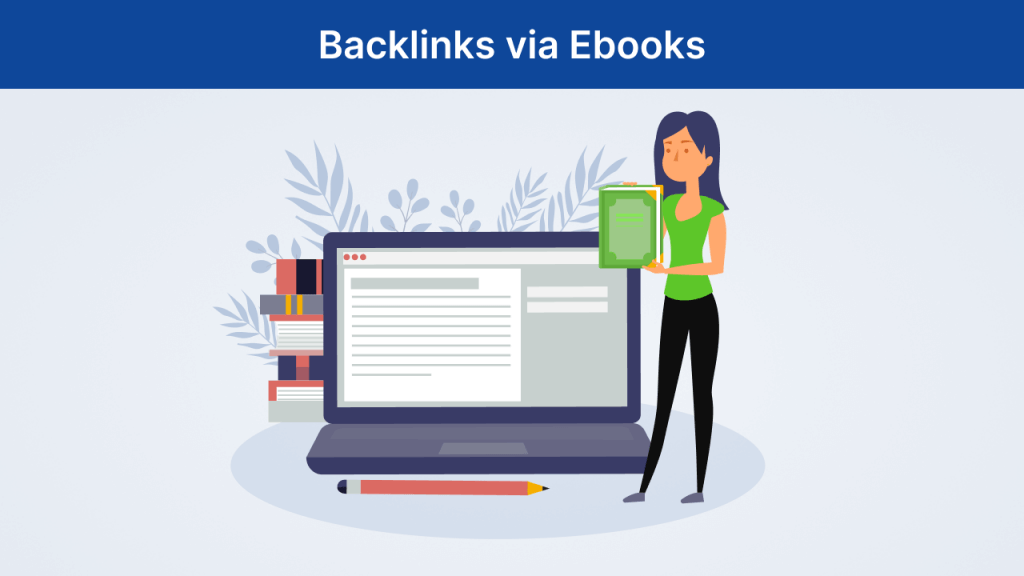
Ebooks can be a great way to build backlinks that are passive and get longer term results. Create high quality Ebooks in PDF format with links pointing to your website. The more the Ebooks are downloaded, the links are exposed and usually well indexed by search engines. They also get you traffic from the Ebook readers.
12. Long form blog posts and research content

Research content and unique long form blog posts or articles are great ways to build backlinks by being authoritative in your niche. Well done research content and analysis add great value to your niche and get your site reputation and backlinks.
Since these types of content are usually one off and cannot be produced on a consistent basis, it is better to be produced after well researched and written by an expert. Promoting this content should be very easy.
13. Buying related websites

With your SEO budget, you can consider buying any website related to your niche in the marketplace and use that website to build backlinks to your main website. In auction sites like flippa.com you can lookout for any websites in the budget that you can continue using as it is, for the purpose of backlinks due to the domain and rankings the website has already gained.
14. Ecommerce sites

When you make purchases online on e-commerce sites like Amazon and Etsy, you can maintain a publicly viewable profile on those sites. You can add your main website link to that public profile.
15. Free blogs

Blog networks like wordpress.com and blogger.com are attractive to create free blogs and also backlinks. Apart from these two , there is Medium which is growing popular as a blogging platform. Medium, a popular blogging platform, is known for its clean design and its focus on quality content. Medium is free to use, but you can also pay for a premium subscription to unlock additional features.